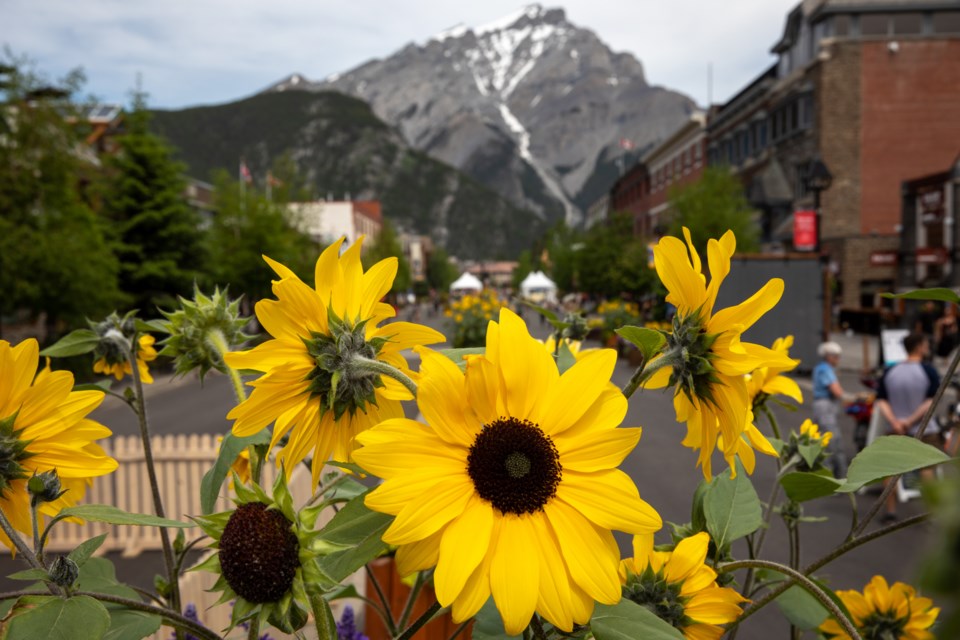BANFF – A local businessman is calling for the elimination of sidewalk restaurants and outdoor retailing in the Banff Avenue pedestrian zone to level the playing field for other businesses in the tourist town without the same opportunity.
Craig Paton, operations manager and managing partner of St. James’ Gate Olde Irish Pub and Elk & Oarsman, said he understands the pedestrian zone has been approved for the next two years, but wants to see it without restaurant seating so it is fairer to those businesses without it.
“It’s having a massive advantage to certain restaurants and a disadvantage to others,” he said during a Feb. 14 council meeting. St. James’ Gate is located on Wolf Street and the Elk & Oarsman on a second-storey on Banff Avenue.
“I know there is always going to be competition, but my concern is this isn’t really a competition that’s equal to everyone … we’ve all had a really, really difficult time and I just want the playing field to be level.”
The pedestrian zone was initially set up for summer 2020 to help deal with the COVID-19 pandemic and attract visitors safely back to Banff after the once thriving tourist community turned into a ghost town during a strict provincial lockdown earlier that spring.
Complete with outdoor retailing and dining, the pedestrian zone aimed to create a vibrant outdoor destination to allow for greater physical distancing and to give struggling businesses an opportunity to offset public health restrictions, such as indoor capacity limits.
Banff Lake Louise Tourism and many other businesses lobbied strongly for the pedestrian zone to continue as a summer fixture to help boost tourism as Banff recovers from the pandemic.
Paton said there will continue to be a great deal of lobbying to keep restaurant seats available on Banff Avenue.
“If you’re making all this additional money, of course, you’re going to lobby; of course, you’re going to want more restaurant seats,” said Paton.
“It’s no longer a health and safety issue, it’s about a financial windfall that becomes available to certain businesses," he added.
“The Gate got killed the last two years. Between the Bear Street development and what was going on Banff Avenue, we struggled mightily in the last two summers.”
Banff’s sidewalk seating policy, along with the outdoor merchandising display policy, will be up for discussion at council’s governance and finance committee meeting on Feb. 28.
Administration is seeking direction from council on a host of issues, including the location of sidewalk seating and outdoor merchandising, eligibility for participation, design standards and fees for use of public space.
Emma Sanborn, a development planner with the Town of Banff, said the overarching goal of both the sidewalk seating and outdoor merchandising display policies is to enhance the public realm and contribute to memorable national park experiences.
“The revised sidewalk seating policy is now four years old, and the recent completion of the Bear Street shared street project and past two years of downtown pedestrian zones have presented new public realm contexts not previously contemplated by the policy,” she said in a report to council.
“A policy review will ensure the program continues to meet council expectations with regards to user fees, policy objectives and community priorities.”
For the 2020 and 2021 pedestrian zones, a priority system was used to determine which applications to process first, with first priority given to at-grade food and beverage operators.
Next second-storey and basement level businesses were given priority for space not used by at-grade food and beverage operators, including retail store frontages. Lastly, at-grade retail could use a 10x10 metre space if the space was not going to be utilized by the previous two groups.
“The priority system was focused around food and beverage operators as these provided more animation and activation of the space over retail offerings,” said Sanborn in her report.
Administration has received a handful of development permit applications for a change of use in recent years for general retail locations, which would like to have a small floor area – as small as five square metres – of eating and drinking use.
“A motivation for these applications has been to adapt and expand their business given the changing nature of the pandemic,” said Sanborn.
“The sidewalk seating policy is currently silent on the topic of how much eating and drinking or kitchen use is required to be eligible for a sidewalk seating area.”
Fees, which are currently based on a seat and table rate, are also up for debate. Other communities have different options, such as Canmore which uses an in-street rate, Aspen, Colorado, with a commercial rate and Whistler, B.C., has a scaled rate.
Over the last years, the Town of Banff brought in $18,300 in revenue from 15 sidewalk seating permits in 2018, $59,490 from 20 permits in 2019. In 2020, fees were waived and in 2021, $99,510 was generated in revenue from 46 permits. Bear Street fees were waived due to construction impacts.
During council’s review of programs and services for the 2022 budget, alternate options for establishing an appropriate rate for sidewalk seating was discussed, including a market rate to charge for space in the public realm.
While market rates in the commercial downtown vary greatly based on visibility and accessibility, administration indicates a $100 square foot assumption is within the range. Various discounts could be applied to the rate to reflect the use of the space based on seasonal use and weather.
In addition, administration has suggested consideration of a surcharge for the Town of Banff to provide standard timber stations and ropes to delineate outdoor restaurant areas, as well menu box signage to achieve a uniform standard to help regulate and harmonize aesthetics of the outdoor seating areas.
“The Bear Street, Wolf Street and Caribou Street trials included a standardized platform and perimeter structure, designed and constructed by the Town of Banff,” said Sanborn in her report. “This provided a consistent aesthetic within the public realm.”




